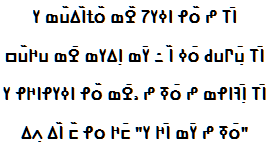Maninka love poem
ߘߎ߬ߡߊ߬ߙߋ߬
ߌ ߘߎ߬ߡߊ߬ߙߋ߬ ߘߐ߬ ߖߌߦߊ ߟߋ߬ ߒ ߠߊ߫
ߛߎ߬ߞߎ ߘߐ߫ ߘߌߡߊ߲ ߘߌ߫ ߸ ߊ߬ ߦߋ߫ ߕߎߣߎ߲߫ ߠߊ߫
ߌ ߟߞߊߟߌߦߊ ߟߋ߬ ߘߐ߫، ߒ ߧߋ߫ ߒ ߘߟߊߓߊ߲߫ ߠߊ߫
ߡߍ߲ ߡߊ߬ ߏ߬ ߟߋ ߞߏ߫ "ߌ ߞߊ߫ ߘߌ߫ ߒ ߧߋ߫"

Romanization
Dùmàrè
í dùmàrè dɔ̀ jíyá` lè Ń ná
sùkú` dɔ́ dímán` dí, à yé túnún ná
í lákálíyá` lè dɔ́, Ń ɲé Ń dálábán ná
mɛ́n` mà ò lé` kó "í ká dí Ń ɲé

→ French poem ←
Maninka language
Maninka love poem in n'ko alphabet (possible alternatives : Malinke, Maninkakan, Wassulunke, Mande, Kankan Maninka, Wassulunka, Malinké, Southern Maninka, Maninga, Amana, Southern Malinke, Maninkaxan, Mori, Wasolon Maninka, Eastern Maninkakan, Wassulu, Southern Maninka, Gbereduu, Madingo, Wasulunkakan, Baliya, Maninka-Mori, Eastern Malinke, Toron, Kourousa, Mandingo, Wasu) of West Africa.
Four verses in a mande language, for the whole Malinke ethnic in Guinea, Mali, Senegal, and Ivory Coast, nearly a million Africans.
Malinke was the language of the great empire of Mali, which reached its zenith in the 14th century and from which the name of the modern country of Mali is derived. Malinke belongs to the Mande branch of the Nigero-Congo family.
The single term Mandingo refer to all its varieties. The word Malinké originates from the French name of the local term.
The alphabet n'ko is the transcription script of the mande languages of West Africa.
In Senegal there are 20 ethnic groups that have preserved their traditions and each speak their own language in a characteristic geographical area.
The Malinkes
Malinke are people from Mali occupying a part of the Niger plain. They live mainly from agriculture (rice, sorghum, millet, fonio). The practice of craft work (weaving, sewing) is reserved to men.
The term Maninka, which is often translated as Mandingo, refers to the inhabitants of Manden which was the heart of the Mali Empire between the 11th and 16th centuries. Currently, the Manden is located straddling the current Mali and Republic of Guinea.
Founded in 1236 by Sunjata Keïta, this former great empire was well known to Europeans, also as a major supplier of gold. We have several medieval planispheres which represent its cartography.
Grouped around a clan, living in fortified villages, each extended family of patrilineal filiation with patrilocal residence, with an endogamous tendency - marriage being regulated by a dowry in money and oxen - was subject to the absolute authority of an elder, and formed an economic, social and legal unit. Organized according to the system of age classes which brought together self-help associations and working societies on the one hand, and initiatory associations on the other.
Malinké society was also hierarchized in differentiated classes - noble, free men , Slaves - involving the distribution of religious roles (caste). The ancestors cult maintained the existing opposition between the traditional religion and the Muslim religion, to which the Malinkés nevertheless adhered.